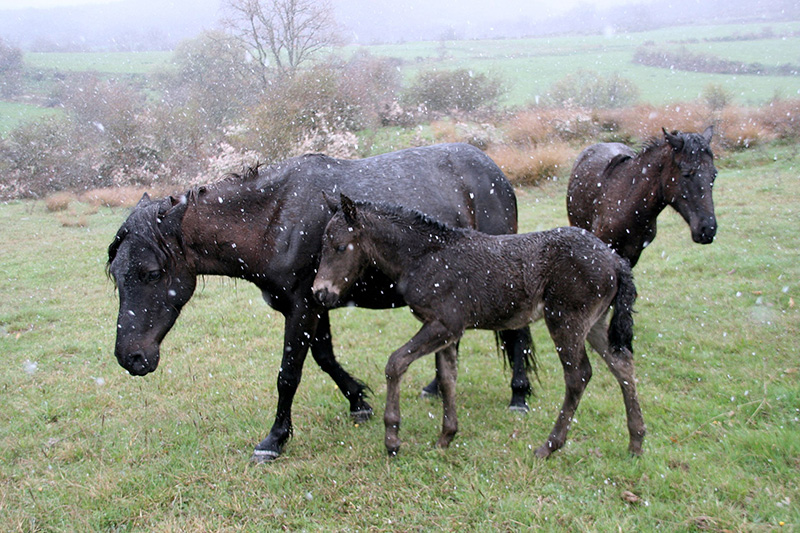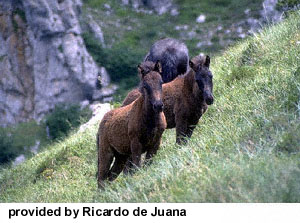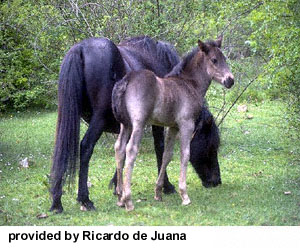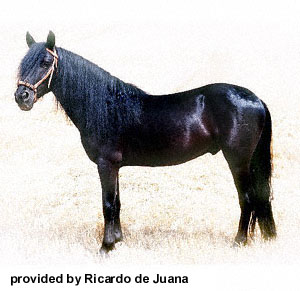Losino Horses
The Losino receives its name from the  original area where it is bred, the Losa Valley, in the north of the province of Burgos
(Spain). It is found to be related to other breeds derived from the Cantabrian-Pyrenean
branch: the Portuguese Garrano, the Galician pony, the Asturian pony, the Thieldon, the Sorraia, the Navarre horse, the Basque Pottok, the Merens horse and the extinct Catalan horse.
original area where it is bred, the Losa Valley, in the north of the province of Burgos
(Spain). It is found to be related to other breeds derived from the Cantabrian-Pyrenean
branch: the Portuguese Garrano, the Galician pony, the Asturian pony, the Thieldon, the Sorraia, the Navarre horse, the Basque Pottok, the Merens horse and the extinct Catalan horse.
The Losino breed maintained its number until the 50's but afterwards, and principally due to farming mechanization, the crossbreeding with meat breeds and donkey populations for mule production, its population declined to the most critical limits of its history in 1986 (around 30 animals). In this year, and due to the alarming situation, a project for recuperating the breed was established, being created in Pancorbo (Burgos) the first Breeding and Selection Center of the Losino Horse. In this center it is maintained a natural and extensive system of breeding. The animals, once captured, broken and tamed, are used for infant-junior horseback riding, harnessing, and to carry out the equestrian routes through rural and mountain zones. The census in 1,999 has reached a population of around 200 animals.
Morphological Characters
Weight
The Losino, according to the Breed Norms of the Losino Horse Breeding Association, must weigh 300 to 350 kg.
Height
Females have an average height to the withers of 135 cm and males of 140 cm.
Head
 A relative large head with fine features. Straight frontal profile, sometimes, with
a slight undulation at nasal levels (stretched out S or foal profile). Small ears,
thin and making a concave interior arch. Flat forehead. Eyes at line of the face,
big, highlighted and expressive. Wide nostrils. Lips relatively thick.
A relative large head with fine features. Straight frontal profile, sometimes, with
a slight undulation at nasal levels (stretched out S or foal profile). Small ears,
thin and making a concave interior arch. Flat forehead. Eyes at line of the face,
big, highlighted and expressive. Wide nostrils. Lips relatively thick.
Neck
A strong neck, of wide insertion in the chest, with a tendency of sticking out in its inferior part making it slightly straight or convex in its superior border.
Torso
The chest is wide, good withers, a little saddled, broad back, wide and inclined hindquarters, tail of low insertion, very thick and black.
Front Quarters
Thin, with good joints and blood vessels, and very evident tendons. The back is wide, good arm, thin forearm, short fetlock joint and small, hard, black hoofs.
Hind Quarters
The thigh is proportioned, good leg, "clean" hocks, sometimes a bit closed. The regions situated below the hocks are analogue to the mentioned in the front extremities.
Phaneroptical Characters
Hair

The hair of the mane and tail is abundant and long, specially in winter as defense from the cold weather. The foals present for almost up to two years a coarse type hair similar to the ones found on donkeys, which later will change for the normal type hair of the breed. In the summer and specially in adults, the hair is short and strong. Do not have fetlocks.
Coat
Only admitted black coat with its varieties blood sausage which could present a reddish tonality in winter and being in summer darker and shinier. May present a white mark in the forehead.
Eliminatory Defects
According to the Losino Horse Breeding Association (1988) the eliminatory defects

considered for this breed are as follow:
- Any variation of the coat that is not black.
- Presence of white spots on the coat other than the one permitted in the forehead.
- Any feature that may lead to suspect of crossbreeding with other breeds.
- Scattered hoofs.
- Too much fetlock.
- Straight or square rump.
- Variations in the forehead-nasal profile that is not that of the breed's.
Contacts
Spanish Losino Horse Breeding Association. (Ricardo de Juana) C/ Antecubia, Nº 6. Pancorbo (BURGOS). Telf. 947-354287
Universidad de Córdoba. Dept. de Genética. Facultad de Veterinaria.
References
Jesus Martinez-Saiz, Genetics Department, University of Cordoba, Spain.
Animal Genetics Resources Information (FAO) number 19, 1996.
Mason I.L. 1960. A World Dictionary of Livestock Breed Types and Varieties.
